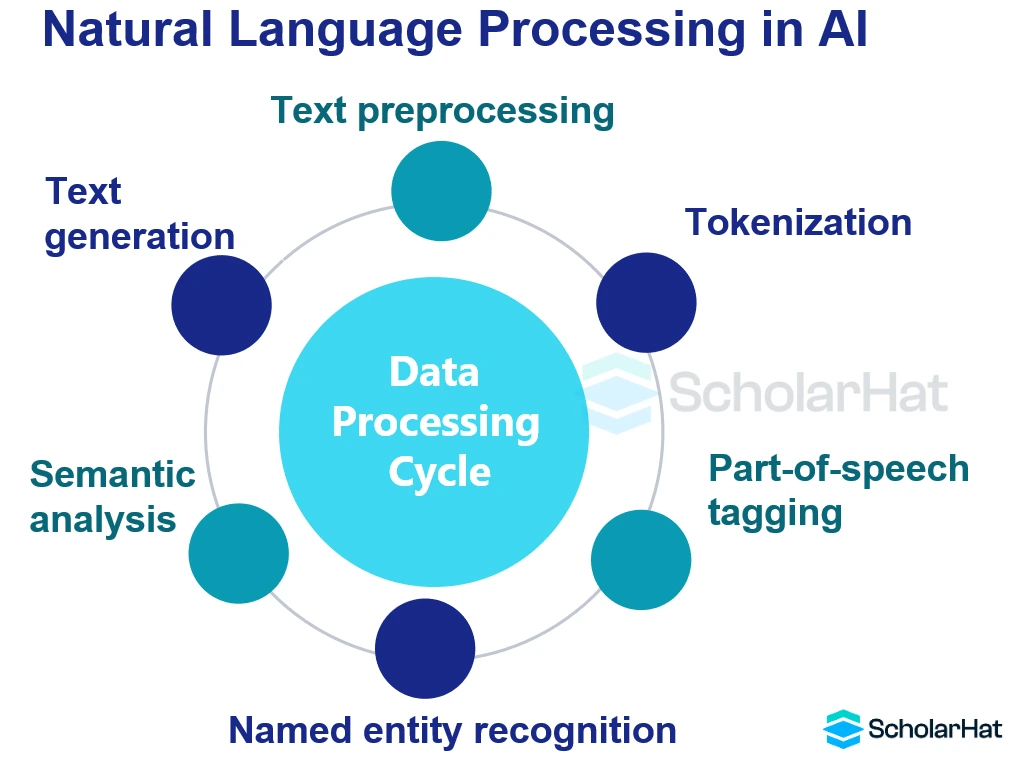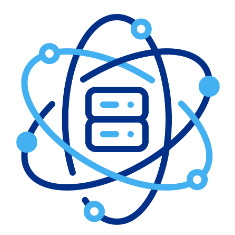18
AprNatural Language Processing in AI
Introduction
Artificial intelligence (AI) has a subfield called Natural Language Processing (NLP) that focuses on how computers and human language interact. It makes it possible for machines to effectively comprehend, translate, and create human language. The use of natural language processing (NLP) has revolutionized how we interact with technology by enabling robots to comprehend and respond to our instructions and inquiries.
Overview of Natural Language Processing (NLP)
An interdisciplinary field called "natural language processing" incorporates methods from computer science, linguistics, and artificial intelligence. It entails the creation of models and algorithms that can process and comprehend human language in all of its manifestations, including spoken language, written text, and even gestures. NLP covers a wide range of activities, including text summarization, sentiment analysis, language translation, and sentiment analysis.

The following are a few of the NLP steps:
- Text preprocessing: Text preprocessing entails cleaning up the text and getting it ready for additional processing. This could entail actions like eliminating stop words, stemming words, and punctuation.
- Tokenization: Tokenization is the process of dividing a text into separate words or phrases.
- Part-of-speech tagging: Tagging each word in the text with its part of speech, such as a noun, verb, adjective, or adverb, is known as part-of-speech tagging.
- Named entity recognition: Named entity recognition entails locating and categorizing named objects in the text, including persons, places, businesses, and items.
- Semantic analysis: This means understanding the text's meaning. This could entail activities like figuring out how words and phrases relate to one another and figuring out the tone of the text.
- Text generation: Text creation is the process of creating new text, such as summaries, translations, or chatbot responses.
How NLP works
How NLP works is described in the following steps:
- Text preprocessing: Remove punctuation, change the case to lowercase, and separate the raw text data into words or tokens to clean and prepare it.
- Extraction of features: To comprehend the meaning and organization of the text, locate significant characteristics such as part-of-speech tags, named entities, or grammatical relationships.
- Numerical Representation: To help machine learning algorithms understand the text, turn it into numerical values using methods like word embeddings or bag-of-words.
- Model Training: To learn patterns and links between the text and desired results, train machine learning models using labeled data.
- Model Application: Use trained models on fresh text input for tasks like sentiment analysis or language translation, drawing on the acquired understanding to produce precise interpretations or answers.
NLP technology
Utilizing a variety of tools and methods, natural language processing processes and comprehends spoken language. NLP uses a number of important nlp technology and methods, including:
- Machine Learning: Machine learning algorithms are essential to NLP because they let computers recognize patterns and connections in language data. While unsupervised learning algorithms are utilized for tasks like topic modeling or clustering, supervised learning algorithms are frequently used for tasks like sentiment analysis or text categorization.
- Deep Learning: A branch of machine learning, deep learning focuses on teaching artificial neural networks to gain knowledge from enormous volumes of data. Recurrent neural networks (RNNs) and transformers are two deep learning algorithms that have attained state-of-the-art performance in a variety of NLP applications, including language translation, speech recognition, and text generation.
- Natural Language Understanding (NLU): NLU is a branch of natural language processing that focuses on figuring out what words mean. It involves activities including sentiment analysis, named entity recognition, and question answering. NLU approaches allow machines to understand the purpose behind a user's inquiry and produce the most suitable answers.
- Natural Language Generation (NLG): NLG is a subset of NLP that focuses on producing human-like language from machine-readable data. Tasks like text summarization, language translation, and chatbot responses all use NLG approaches. Machines can now produce language that is coherent, contextually appropriate and resembles human communication thanks to NLG algorithms.
NLP applications
There are several uses for natural language processing in numerous fields and sectors. Among the most significant NLP applications are:
- Virtual assistants: NLP is a key component of how virtual assistants like Apple's Siri and Amazon's Alexa comprehend and respond to user orders and inquiries. These virtual assistants can make reminders, do web searches, and manage smart home devices thanks to NLP.
- Sentimental Evaluation: Opinion mining, another name for sentiment analysis, is the process of removing arbitrary information from text data. NLP algorithms can examine news stories, consumer reviews, and social media posts to ascertain the author's sentiment or opinion. In marketing, customer feedback analysis, or reputation management, sentiment analysis is frequently employed.
- Language Translation: One of the most well-known uses of NLP is in language translation. NLP algorithms provide seamless communication across various cultures and languages by automatically translating text from one language to another. NLP approaches are used by machine translation systems like Google Translate to produce precise and insightful translations.
- Question-Answering: Systems that can comprehend user inquiries and provide relevant answers can be created using NLP algorithms. Wherever consumers need prompt and precise replies to their questions, such as in customer service, information retrieval, or instructional applications, these systems can be deployed.
Benefits of Natural Language Processing in AI
Natural Language Processing's incorporation with AI has produced a wide range of advantages and improvements in a number of fields. A few of the main advantages of NLP in AI are as follows:
- Improved Human-Computer Interaction: NLP makes it possible for computers to comprehend human language and reply in a way that feels intuitive and natural. This led to the creation of voice-activated technology, chatbots, and virtual assistants that can comprehend and carry out human directions.
- Effective Information Retrieval: NLP systems can analyze significant amounts of unstructured text and extract pertinent information, improving the effectiveness and accuracy of information retrieval. This is especially helpful in industries like data analysis, healthcare, and legal research where quick access to pertinent information is essential.
- Improved Customer Experience: NLP-powered chatbots and virtual assistants can offer individualized and effective customer care, enhancing the entire customer experience. These AI-powered systems are capable of comprehending consumer inquiries, offering pertinent information, and even carrying out actions like scheduling appointments or fulfilling orders.
- Automated Language Processing: NLP algorithms are capable of speeding up time-consuming language processing tasks like text summarising or translation. In comparison to how long it would take a human, this enables organizations to handle and analyze massive amounts of text data much faster.
Best Practices of NLP in AI
Here are several AI NLP best practices:
- Make sure the training data are of the highest quality.
- Use the correct text preparation methods.
- Choose and design pertinent features.
- Decide on the best NLP model architecture.
- Utilise pre-trained models and transfer learning.
- Establish the proper evaluation metrics.
- When handling data and models, take ethical considerations into account.
- use a method of iterative development.
- Retrain and update models frequently.
- Consider robustness and handling of errors.
Resources for further Learning and Practice
Online tutorials and courses: Explore Additional Learning and Practice Resources with us at https://www.scholarhat.com/training/artificial-intelligence-certification-training. There are numerous online tutorials and courses available that specifically focus on Artificial Intelligence.
Summary
Computers can now interpret, produce, and translate human language thanks to a technique called natural language processing (NLP). It transforms how people interact with computers by enabling robots to understand commands and inquiries. Text preparation, tokenization, part-of-speech tagging, named entity recognition, semantic analysis, & text generation are some NLP technology. NLP applications include virtual assistants, sentiment analysis, translation, & question-answering systems and draw on machine learning, deep learning, NLU, and NLG. It improves interaction, information retrieval, and consumer experiences, and automates linguistic jobs to improve AI. Data quality, preprocessing, feature engineering, model selection, transfer learning, ethics, iterative development, frequent updates, and robustness are all best practices.







